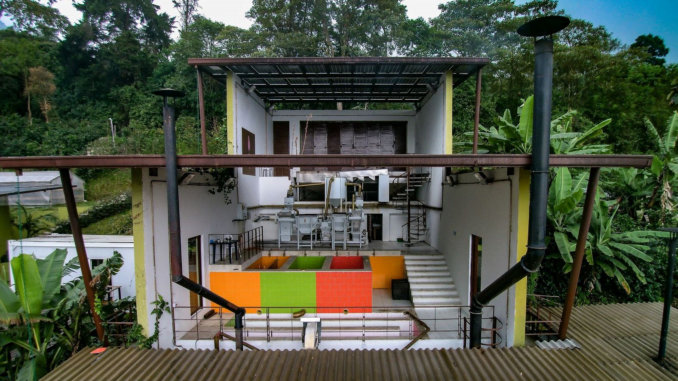This is the next installment in our series of processing. We will be examining the lactose process, which is a complex technique that can yield astonishing results.
BY TANA NANETTI
SENIOR ONLINE CORRESPONDENT
Photos by Felipe Sardi
A cup of coffee that is well-brewed can be awash with different flavors and aromas, all of which are tightly connected to the numerous elements of the coffee. Origin of the coffee, the variety, the processing and roasting methods all affect the final taste, so it is important to understand these factors more thoroughly, including the processes involved in making coffee.
Alongside the traditional methods (natural washed, washed and honey) In recent years, various methods have begun to be used. Anaerobic, lactic doubleand triple-fermented as well as thermo shock are some of the newest coffee processing techniques and it seems that more methods of processing are continually being developed and researched.
The Lactic Process: Introduction to the Lactic Process
To encourage lactic fermentation, producers create an ideal setting to encourage the development of lactobacillus cultures, which are the same bacteria that are utilized in dairy production and responsible for the production of acidic lactic compounds. They accomplish this by placing high sugary coffee cherries in an anaerobic (without oxygen) tank and allowing the cherries to ferment. They control the process with care by monitoring temperatures, pH levels and oxygen levels in order to determine the ideal conditions for lactobacillus to thrive and control the process.
Felipe Sardi, co-founder of the coffee farm La Palma y El Tucan assists us in understanding more about the process of lactic beginning with the genesis of their lactic-processed beans.
“When we started processing coffee cherries inside the wet mill, we quickly were captivated by the complexity of the whole process and saw an enormous opportunity to innovate and test,” Felipe says. “We slowly began to realize that by fermenting, we actually triggered the process of acidification and breakdown of sugars. Since microorganisms eat sugars to produce organic acids, ethanol and carbon dioxide there is a decline in Brix levels (the measure of the sugar levels) of coffee mucilage. It is then removed.”
Felipe adds, “We noticed that by controlling the fermentation conditions, the fermentation environment could have an enormous effect on the final product. In the beginning we found that the humidity and temperature could accelerate the process, which led to the destruction of several batches (and) increasing the likelihood of fungus growth. This affected the fruit and created unpleasant flavors as a result. Learning to manage the various variables was a revelation for us and allowed us to achieve our goal of creating different flavor profiles that in turn opened the door into the realm of lacto-processed coffees.”
How It Works
“This method of fermentation is referred to as anaerobic because oxygen has little interaction with the cherry , and there isn’t any agitation,” Felipe explains. Felipe. “The cherries of the coffee are stored in tanks sealed after being sorted by hand upon arrival at the mill that is wet. The elimination of oxygen during this stage results in a higher concentration of bacteria that produce lactic acid (and consequently of lactic acid) after the fermentation of the carbohydrate in the Mucilage, which enhances the organoleptic flavor of the resulting coffee. The coffee cherries that are processed using the lactic-fermentation process typically arrive at our wet mill with high Brix degree and pH readings. these conditions can aid in the process of fermentation to surpass the minimum duration of 80 hours that is required for any fermentation process.”
The lactic process usually enhances the sense of body’s presence in the cup’s profile. This is why the process of lactic is often found in coffee cherries from farms at high altitudes These cherries typically contain more muclage, which helps balance the flavor profile of the coffee.
Potential Challenges
As with other methods of processing the lactic process may be difficult to implement and can have its own negatives.
“One of the risks (from an agricultural point of perspective) of examining lactic processes is that it is difficult of staying clear of phenols and excessively fermented coffees,” Felipe says. “Due to the lengthy time in which we can extend the pulp fermentation and the control of moisture content that we must follow when drying it is a highly dangerous coffee process. The drying and fermentation times alter with the changing temperatures and levels of humidity at the farm, and also the (number) of kilograms of each batch.”
With many variables to consider many things can go wrong. Felipe says that preparing an “recipe” to create the perfect process of lactic is a complex. “Pushing the limits of the lactic process to much can result in an overwhelming bitterness and unbalanced drinks, since we’re significantly altering the body’s perception over other aspects like sweetness and acidity.”
If everything goes as planned If everything goes according to plan, a lactic-processed coffee will result in a sweet cup with medium-high body. It will possess a distinct acidity profile that is lactic and tropical fruit flavors/aftertastes, and a finish that could remind you of the taste of pineapple yogurt or papaya. If the producers can master the process of lactic fermentation, the result can be extremely satisfying.
About the Author
Tanya Nanetti (she/her) is a barista for specialty coffee who is a traveler as well as a dreamer. When she’s not working behind the machine (or exploring a hidden area of the globe) she’s busy creating content for Coffee Insurrection the website that focuses on specialty coffees she’s developing with her boyfriend.
This article was first published at Barista Magazine, an online magazine dedicated to baristas and coffee professionals.
